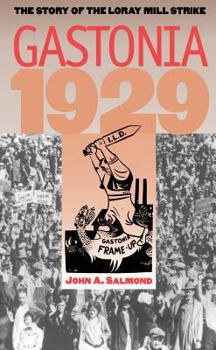Gastonia 1929: The Story of the Loray Mill Strike
Select Format
Select Condition 
Book Overview
Of the wave of labor strikes that swept through the South in 1929, the one at the Loray Mill in Gastonia, North Carolina, is perhaps the best remembered. In Gastonia 1929 John Salmond provides the first detailed account of the complex events surrounding the strike at the largest textile mill in the Southeast. His compelling narrative unravels the confusing story of the shooting of the town's police chief, the trials of the alleged killers, the unsolved murder of striker Ella May Wiggins, and the strike leaders' conviction and subsequent flight to the Soviet Union. Describing the intensifying climate of violence in the region, Salmond presents the strike within the context of the southern vigilante tradition and as an important chapter in American economic and labor history in the years after World War I. He draws particular attention to the crucial role played by women as both supporters and leaders of the strike, and he highlights the importance of race and class issues in the unfolding of events.
Format:Hardcover
Language:English
ISBN:080782237X
ISBN13:9780807822371
Release Date:January 1995
Publisher:University of North Carolina Press
Length:240 Pages
Weight:1.35 lbs.
Dimensions:0.8" x 6.1" x 9.3"
Customer Reviews
2 ratings
A Well researched history of the Loray Mill Strike
Published by Thriftbooks.com User , 17 years ago
Salmond's work is a much needed book on a crucial strike in southern industrial history. The book is excellently researched, drawing on interviews with former participants of the strike and an abundant source of contemporary newspapers. The book is in narrative form; however, Salmond provides important analyses in explaining the causes of the strike, what distinguished the Loray Mill Strike, and the author does a good job of placing the strike in its historical context. This is a must read for students of American industrial and labor history, and I would recommend "Gastonia: 1929" to anyone interested in Southern history.
A bizarre episode in southern history explained.
Published by Thriftbooks.com User , 27 years ago
On the eve of the Great Depression, textile workers in Gastonia, North Carolina, walked out of the town's largest plant to protest management's efforts to speed up the production line. The Communist-led National Textile Workers Union saw the walkout as an opportunity to unionize southern industry and sent veterans of the Passaic textile strike to assume leadership. Two years after the execution of Sacco and Vanzetti, Gastonia quickly became an international cause celebre. Despite daily coverage in the New York Times and other major newspapers at the time and the later publication of six novels on the strike, the walkout has long since been forgotten. John Salmond's account brings to life the bizarre collision between the Communist Party and Bible Belt populism, which resulted in the murders under mysterious circumstances of Gastonia's police chief and a striker who was a talented country singer, kidnappings, ghost sightings in the Mecklenburg County Courthouse, and the eventual escape of the strike's leaders to the Soviet Union. For me, a particularly telling instance of cultural incomprehension was the decision of a sidewalk Pentecostal preacher to quit the strike because his participation conflicted with the "principles" of the Ku Klux Klan. A few weeks later, the national leadership of the NTWU decided to spotlight the union's dedication to racial integration in its strike pamphlets, eroding local support. (This was 1929, and the KKK had yet to become disreputable, even in some northern states.) Given the charged and intemperate nature of the contemporary accounts, I appreciated Salmond's efforts to sort out where accounts agree and where they conflict. I highly recommend this exceptionally well-written and fair-minded book






